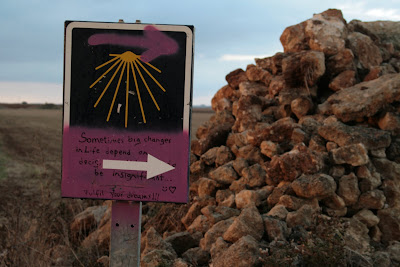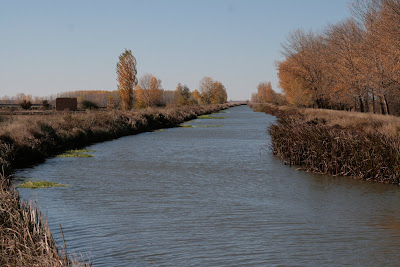02/11/07
Monasterio Santa Clara
Carrion de los Condes, Spain
I’m now half way through the famed meseta. For me it is a country rich in beauty and inspiration, but for others it is a desolate, barren, boring stretch of earth. Some pilgrims even bypass it altogether, opting rather to catch a bus from Burgos to Leon to avoid the week’s worth of walking in between. I spoke to a few who were taking this option, fearing the area’s reputation for mind games and boredom. “Like a desert”, one German pilgrim I spoke to said, “I like to walk in nature and the meseta is so boring. I don’t like this, not for my holiday.” But others say that when you shy away from walking the meseta you miss out on some of the most exciting and fascinating days of the journey. Needless to say I was quite curious as to what is was exactly that provoked such polarised responses from people.
To my Australian eyes the meseta is a populous area of fertile soil and plenty of agriculture. Even here – ‘in the middle of nowhere’ – you are only ever 10-15km from a town. But I can well understand that for some Europeans it may appear empty, even forbidding. That some sections of the French route from Le Puy (particularly the Causse) are equally empty seems to slip many people’s mind (possibly because it is so heavily forested), yet for me the meseta was arrestingly beautiful.
My second day on the meseta started in the blue-grey half-light of a very cold morning in Hornillos. Despite being under four layers of clothes I was still cold as I set out for Castrojeriz. After half an hour or so, having left all my other companions behind in my attempt to get warm by walking fast(er), I found myself at the top of the plateau below which Hornillos sits. The wind, which the valley had sheltered me from, was icy and bitter. 10km of flat land gives the air a chance to really get up to speed, and its temperature to crash. But visually a tonal feast was laid out before me. The climb up had been an affair in grey – slate sky above, apparently unmoving; to left and right fields of freshly tilled earth sang of the tonal wealth of grey, the Camino itself a ribbon of yellow gravel through it all. Here on the plateau, however, the soil had changed, all-of-a-sudden becoming rich earth-red. As I arrived at the top the sun peaked above the horizon – the cloudy sky glowed apricot to the horizon and the brief direct sun lit the rude dirt.
It was glorious, and with the icy fingers of the wind beginning to grip me tightly, I walked as fast as I could and sang at the top of my lungs, all alone on the beautiful meseta.

The following day was equally stunning, though thankfully somewhat warmer. The climb out from Castrojeriz (which also sits in a valley) gave one a definitive picture of the surrounding country – flat. But again, eyes were drawn all morning to the palate of earthen hues. Had I been a painter I think I may have lingered longer than was healthy, drinking the colours in. The afternoon was no less inspiring. Shortly after leaving Boadilla the Camino runs along side the Canal Castilla to Fromista. This section (some 4km or so) was stunning. Poplars, leaves a late autumn gold, lined the canal, rustling in the fresh breeze. Alone again (companions in front and behind), I found a rhythm and walked, body on automatic. As happened so often I watched the landscape, as if my head were somehow separate from my body, drinking in the colours and little impressionist picture-scapes roll by.

My point is it’s beautiful. But it’s true, it can be a challenging place for the mind. Burgos to Leon took me seven days to walk, during which there was really only one hill and a couple of valleys. Such flat country results in a very steady marching pace, and the apparently unchanging landscape can make even short distances seem endless. The rhythmic motion of the walking body and the relentless earth and sky turn the mind inwards, possibly for days on end, and this is a great challenge for many. All I suppose, at least in some form or another.
In our everyday lives we rarely have the chance for such prolonged periods of introspection. Nor are we taught what to do when such opportunities are given us – “What do I do now?” “What should I think about?” As many meditative traditions tell us, the first thing the conscious mind likes to do when faced with only itself is start looking for distractions. It’s a crisis response, really. “This is so boring,” we tell ourselves. “Why have I spent so much money to come here and look at nothing, walking through a flat land with nothing in it?” Fingernails are cleaned, heads scratched, clothes adjusted - but all this runs out quite quickly and prompting a concert of songs sung in the head (note the rhythmic gait... the mind loves that one and capitalises on it). But with patience we regain control and can start thinking about the big issues in life. Because, after all, isn’t that what this whole enterprise is about?
On top of this is our notion of travel itself. Somewhere along the way we have come to conceive of travel to a place meaning that the place must have ‘things’ in it worth seeing. The idea that we would choose to go somewhere with ‘nothing’ disturbs us. It is material culture personified. But while we externalise the source of that disturbance, blaming it – “There’s nothing here to see… Let’s blow this joint” – the problem is, in fact, us. The lack of external stimuli leaves us with ourselves, and as a rule we don’t like ‘me’ that much. De Botton even argues that this is the eternal disappointment of all travel, the reason why the reality never looks as good as the picture in the book or the brochure. The picture doesn’t have the thing that causes us the most tension in our lives – us – and thus looks idyllic. When we go on holiday, what we are really seeking escape from is ourselves. So it is quite understandable that when faced with a situation like walking through the meseta, with 7-8 days of only ourselves for company, that our minds might embark upon a hardcore campaign of mental distraction and game playing. Anything to stop us thinking about 'me'.
Getting back to those old meditative traditions again, the common consensus is that just letting thoughts come and go is the best solution. But like the empty land the empty mind seems to be a thing feared. We go to great lengths in order to avoid the terrible peace of quiet. This is classic meseta syndrome and has been responsible for many a bus ticket purchase. The secret is to just keep walking. Jack Kornfield, an American Buddhist and writer, wrote that the conscious mind is like a puppy. To train it to be quiet requires patience and repeatedly bringing it back every time it wanders. The beautiful, empty, flat land, the rhythmic gait, and the cascades of uncalled for thoughts make the meseta far from boring. Sure it’s hard work mentally (and emotionally), but then the whole Camino is hard work. If anything it’s full on, life at high speed, your life in an opportunity to experience it in ways that few of us will have again. The meseta can help present it to you, so take it, it’s yours.
More: Full post
